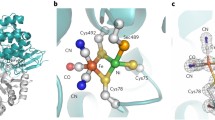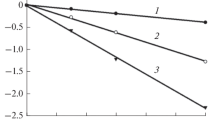Abstract
It has been established that the hydrogenase from autotrophically cultured Bradyrhizobium japonicum contains selenium as a bound constituent. About 80% of the enzyme selenium remains bound during precipitation with 5% trichloroacetic acid (TCA). However, 85% of the selenium bound to the enzyme is released by a combined treatment of urea, heat and TCA. Neither selenomethionine nor selenocysteine could be detected on analysis of anaerobically hydrolyzed enzyme. These results are consistent with the report showing that the structural genes for this enzyme do not contain a TGA codon (Sayavedra-Soto et al. 1988) which has been reported to code for selenocysteine incorporation into several proteins (Chambers et al. 1986; Zinoni et al. 1986; Stadtman 1987). We have demonstrated that 75Se from the labeled hydrolyzed enzyme forms the derivative' selenodicysteine. The form of selenium resulting in the synthesis of this derivative apparently is SeO sup=inf3 or a compound such as Se= which is easily oxidized to SeO sup=inf3 . In a separate approach it was established that 12–16% of the total 75Se in the native enzyme reacted with 2,3-diaminonaphthalene indicating that this fraction was present as SeO sup=inf3 . The remaining 75Se was bound to the enzyme protein. From this research, we concluded that Se in Bradyrhizobium japonicum hydrogenase is present in a labile bound form. In this respect, this enzyme is similar to xanthine dehydrogenase and nicotinic acid hydroxylase, both of which contain labile Se constituents that have not been defined.
Similar content being viewed by others
Change history
01 January 1991
Figure 5A and B was inadvertently placed where Fig. 4A and B should have appeared and vice versa, so that each was over the legend to the other
References
Beilstein MA, Whanger PD (1986) Chemical forms of selenium in rat tissues after administration of selenite or selenomethionine. J Nutr 116: 1711–1719
Beilstein MA, Whanger PD (1988) Glutathione peroxidase activity and chemical forms of selenium in tissue of rats given selenite or selenomethionine. J Inorg Biochem 33: 31–46
Beilstein MA, Tripp MJ, Whanger PD (1981) Evidence for selenocysteine in ovine organelles. J Inorg Biochem 15: 339–347
Boursier P, Hanus FJ, Papen H, Becker MM, Russell SA, Evans HJ (1988) Selenium increases hydrogenase expression in autotrophically cultured Bradyrhizobium japonicum and is a constituent of the purified enzyme. J Bacteriol 170: 5594–5600
Bradford MM (1976) A rapid and sensitive method for the quantitation of microgram quantities of protein utilizing the principle of protein-dye binding. Anal Biochem 72: 248–254
Broderick DJ, Beilstein MA, Whanger PD (1985) Problems associated with hydrolysis of selenium containing proteins Fed Proc 44: 1509
Chambers I, Frampton J, Goldfarb P, Affara N, McBain W, Harrison PR (1986) The structure of the mouse glutathione peroxidase gene: the selenocysteine in the active site is encoded by the “termination” codon, TGA. EMBO J 5: 1221–1227
Dilworth GL (1982) Properties of the selenium-containing moiety of nicotinic acid hydroxylase from Clostridium barkeri. Arch Biochem Biophys 219: 30–38
Eidsness MK, Scott RA, Prickril BC, Der Vartanian DV, Legall J, Moura I, Moura JJG, Peck HD Jr (1989) Evidence for selenocysteine coordination to the active site nickel in the [NiFeSe] hydrogenase from Desulfovibrio baculatus. Proc Natl Acad Sci USA 86: 147–151
Enoch HG, Lester RL (1975) The purification and properties of formate dehydrogenase and nitrate reductase from Escherichia coli. Biol Chem 250: 6693–6705
Evans HJ, Harker AR, Papen H, Russell SA, Hanus FJ, Zuber M (1987) Physiology, biochemistry and genetics of the uptake hydrogenase in Rhizobium. Annu Rev Microbiol 41: 335–361
Flohe L, Gunzler WA, Schock HH (1973) Glutathione peroxidase: a selenoenzyme. FEBS Lett 32: 132–134
Ganther HE (1968) Selenotrisulfies. Formation by the reaction of thiols with selenious acid. Biochemistry 7: 2898–2905
Harker AR, Xu LS, Hanus FJ, Evans HJ (1984) Some properties of the nickel-containing hydrogenase of chemolithotrophically grown Rhizobium japonicum. J Bacteriol 159: 850–856
Jones JB, Stadtman TC (1981) Selenium-dependent and selenium-independent formate dehydrogenases of Methanococcus vannielii. J Biol Chem 256: 656–663
Laemmli UK (1970) Cleavage of structural proteins during the assembly of the head of bacteriophage T4. Nature 227: 680–685
Menon NK, Peck HD Jr, LeGall J, Przybyla AE (1987) Cloning and sequencing of the genes encoding the large and small subunits of the periplasmic (NiFeSe) hydrogenase of Desulfovibrio baculatus. J Bacteriol 169: 5401–5407
Olsen OE (1969) Fluorometric analysis of selenium in plants. J Assoc Off Anal Chem 52: 627–634
Rotruck JT, Pope AL, Ganther H, Swanson AB, Hateman DG, Hoekstra WG (1973) Selenium: biochemical role as a component of glutathione peroxidase. Science 179: 588–590
Sayavedra-Soto LA, Powell GK, Evans HJ, Morris RO (1988) Nucleotide sequence of the genetic loci encoding subunits of Bradyrhizobium japonicum uptake hydrogenase. Proc Natl Acad Sci USA 85: 8395–8399
Seefeldt LC, Arp DJ (1989) Oxygen effects on the nickel and iron containing hydrogenase from Azotobacter vinelandii. Biochemistry 28: 1588–1596
Stadtman TC (1984) Occurrence and characterization of selenocysteine in proteins. Methods Enzymol 107: 576–581
Stadtman TC (1985) Specific occurrence of selenium in certain enzymes and amino acid transfer ribonucleic acids. Phosphorus Sulfur Relat Elem 24: 199–216 [579–596]
Stadtman TC (1987) Specific occurrence of selenium in enzymes and amino acid tRNAs. FASEB J 1: 375–379
Teixeira M, Fauque G, Moura I, Lespinat PA, Berlier Y, Prickril B Peck HD Jr, Xavier AV, LeGall J, Moura JG (1987) Nickel-(iron sulfur)-selenium-containing hydrogenase from Desulfovibrio baculatus 1743. Eur J Biochem 167: 47–58
Turner DC, Stadtman TC (1973) Purification of protein components if the clostrial glycine reductase system and characterization of protein A as a selenoprotein. Arch Biochem Biophys 154: 366–381
Wagner R, Andreesen JR (1977) Differentiation between Clostridium acidiurici and Clostridium cylindrosporum on the basis of specific metal requirements for formate dehydrogenase formation. Arch Microbiol 114: 219–224
Wagner R, Andreesen JR (1979) Selenium requirement for active xanthine dehydrogenase from Clostridium acidiurici and Clostridium cylindrosporum. Arch Microbiol 121: 255–260
Wagner R, Cammack R, Andreesen JR (1984) Purification and characterization of xanthine dehydrogenase from Clostridium acidiurici grown in the presence of selenium. Biochim Biophys Acta 791: 63–74
Wen TN, Li C, Chan CS (1988) Ubiquity of selenium-containing tRNA in plants. Plant Sci 57: 185–193
Yamazaki S (1982) A selenium-containing hydrogenase from Methanococcus vannielii. Identification of the selenium moiety as a selenocysteine residue. J Biol Chem 257: 7926–7929
Zinoni F, Burkmann A, Stadtman TC, Bock A (1986) Nucleotide sequence and expression of the selenocysteine-containing polypeptide of formate dehydrogenase (formate-hydrogen-lyase-linked) from Escherichia coli. Proc Natl Acad Sci USA 83: 4650–4654
Author information
Authors and Affiliations
Additional information
Technical paper no. 8980 from the Oregon Agricultural Experiment Station
Rights and permissions
About this article
Cite this article
Hsu, JC., Beilstein, M.A., Whanger, P.D. et al. Investigation of the form of selenium in the hydrogenase from chemolithotrophically cultured Bradyrhizobium japonicum . Arch. Microbiol. 154, 215–220 (1990). https://doi.org/10.1007/BF00248957
Received:
Accepted:
Issue Date:
DOI: https://doi.org/10.1007/BF00248957




